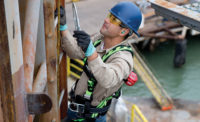Hearing protection devices (HPD) today are typically selected based on criteria that seem simple but may lead to problems in real-world application. After the all-important price point, the key criterion for most users is noise reduction rating (NRR). Most users select HPD with the highest available NRR, assuming that “bigger is better.†But understanding the NRR and the HPD evaluation process can lead to better decision making and more realistic application of HPD evaluation findings.
Calculating NRR
For many kinds of HPD, OSHA uses the EPA evaluation process described in 40CFR211 Subpart B, employing the procedures in American National Standards Institute (ANSI) standard S3.19-1974. Even though ANSI’s standards for HPD evaluation have been updated several times in the intervening 30 years, EPA’s direct reference to the 1974 standard has functionally frozen that reference in time. ANSI’s most recent update is S12.6-1997 (reaffirmed in 2002).S3.19-1974 is a statistically derived, population-based estimate of HPD performance. It requires a panel of ten normal-hearing test subjects. An “experimenter†puts the HPD on the test subjects, giving no consideration to how the HPD will be used in actual application in noise.
The test is designed to assess the attenuation capability of the HPD, not how it will perform in actual use. The subject takes hearing tests with and without the HPD in place; the difference is a measure of the attenuation provided by the HPD. NRR is calculated by averaging attenuation results and applying statistical corrections to provide a level of confidence in the findings.
The bad news
The bad news is that field studies have repeatedly shown that NRR has little relationship to the amount of protection actually achieved by real users in noisy environments. While the S3.19-1974 process measures what it is designed to measure very well — the attenuation capability of HPD — it has been shown to grossly overestimate the protection actually obtained by users in practice. Further, the effect is not linear — higher lab NRR does not equate with higher field attenuation.Part of the problem lies in the evaluation process itself. The intervention of the experimenter ensures that during the test the HPD will be used perfectly and that attenuation will be optimized. No allowance is made for real-world conditions.
Overprotection may be another factor. NIOSH indicates that 90 percent of noise exposures in U.S. industry are less than 95 dB. Thus, 90 percent of noise-exposed workers need between 10 and 15 dB of protection from noise to keep them safe. If we provide them with HPD that gives them up to 30 dB of protection if used properly, is it any wonder that they misuse the protectors in order to perform such basic tasks as communicate with co-workers, listen to their machines, etc.
Derating schemes have had an interesting effect on the HPD marketplace. Since HPD manufacturers know that most users will cut their labeled NRR value at least in half, there is increased pressure to produce products with higher and higher NRRs — which leads to more end-user problems with overprotection, yielding less field attenuation, and leading to less respect for the NRR. Simply put, it’s tough to trust the NRR number on the HPD label. The devices simply do not perform in the real world like they do in the lab.
What’s being done?
EPA has reopened the book on HPD evaluation by stating their intention to revisit and update 40CFR211 Subpart B. This, combined with the ongoing work of the standards community, will likely serve as the basis for revision of the guiding EPA document.The revision will have to deal with more than just an update to new standards, however. In the intervening 30 years, significant technological developments have been introduced that may not lend themselves easily to even the newest ANSI standard.
The NRR attenuation estimation process is a substitute for personal, individual HPD attenuation assessments. How will EPA deal with the new technologies that obviate the need for NRR by developing personal attenuation rating?
EPA reevaluating its HPD evaluation process is a good first step. In the interim, hearing conservation program managers are wise to use the NRR as only one aspect of HPD selection.
